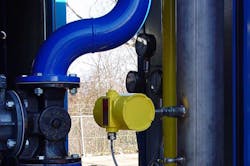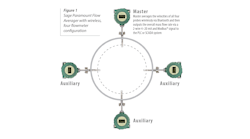New Thermal Flow Meters Developed for Environmental Markets
Like the Coriolis flow meter, thermal flow meters measure mass flow, but their method is different. Instead of using fluid momentum, thermal meters use the thermal or heat conducting properties of fluids. Most measure gas flow, but some also measure liquid flow.
Some thermal meter technologies measure the speed at which heat added to the flow stream disperses, while others measure the temperature difference between a heated sensor and the ambient flow stream. The meters typically require one or more temperature sensors to measure the fluid temperature at specific points.
Industrial thermal meters use a concept similar to hot wire anemometers. The small, fragile anemometers are used in velocity profile and turbulence research and are susceptible to breakage and to contamination from dirt. By contrast, the industrial thermal meters use rugged sensors that are better adapted to industrial environments while still measuring the speed of heat dissipation to determine mass flow.
Advantages & Disadvantages
Thermal flow meters’ niche comes from their relatively low purchase price along with their ability to measure the flow of some low-pressure gases that are not dense enough for Coriolis meters to measure. However, they only offer low to medium accuracy. Some can achieve accuracy levels of 1 percent, but others are in the 3 to 5 percent range.
While thermal meters can uniquely support many gas flow applications, including process gas and other non-custody transfer applications, they are limited in their application for liquids and are not a good fit for steam flow measurement. The meters also do not have the necessary industry approvals for use with custody-transfer of natural gas in pipelines. This market is dominated by ultrasonic, turbine and differential pressure flow meters, all of which have custody-transfer approvals from the American Gas Association. Thermal meters are unlikely to get this approval without technological breakthroughs.
The Development of Multipoint Thermal Meters
In response to new environmental requirements in recent decades, thermal meter companies developed multipoint thermal flow meters. For example, the Environmental Protection Agency has initiated a program to reduce pollution in the atmosphere, paving the way for a new industry around continuous emission monitoring systems (CEMs). For CEM in large stacks emitting pollution from industrial sources, multipoint thermal flow meters measure gas flow at up to 16 points and use these values to compute flow for the entire pipe, duct or stack. Single-point thermal meters measure flow at one point, making it difficult to accurately compute flow in a large pipe or smokestack.
Today thermal flow meters compete with ultrasonic and differential pressure flow meters using averaging Pitot tubes for flue gas monitoring. Thermal flow meters measure the flow of gases through flues, including large pipes, stacks, ducts or chimneys that dispose of gases created by a combustion process.
Thermal meters also compete in the same markets for flare gas monitoring systems that burn waste gases from refineries, process plants and power plants. Thermal flow meters measure the amount of gas flared in either a single pipe or network of pipes. These too are subject to environmental regulations.
To read more about Flow Research’s latest research on thermal flow measurement, visit www.flowvolumex.com. Jesse Yoder, Ph.D., is president of Flow Research Inc. in Wakefield, Massachusetts, a company he founded in 1998. He has 28 years of experience as an analyst and writer in instrumentation. He holds a U.S. patent on a dual-tube meter design and is the author of The Tao of Measurement, published by ISA. Dr. Yoder also founded the Flowmeter Recalibration Working Group, addressing the topic of recalibration frequency. He may be reached at jesse@flowresearch.com.
Jesse Yoder
Jesse Yoder, Ph.D., is president of Flow Research Inc. He has 30 years of experience as an analyst and writer in instrumentation. Yoder holds two U.S. patents on a dual-tube meter design and is the author of "The Tao of Measurement," published by ISA. He may be reached at jesse@flowresearch.com. Find more information on the latest study from Flow Research, "The World Market for Gas Flow Measurement, 4th Edition," at www.gasflows.com.


